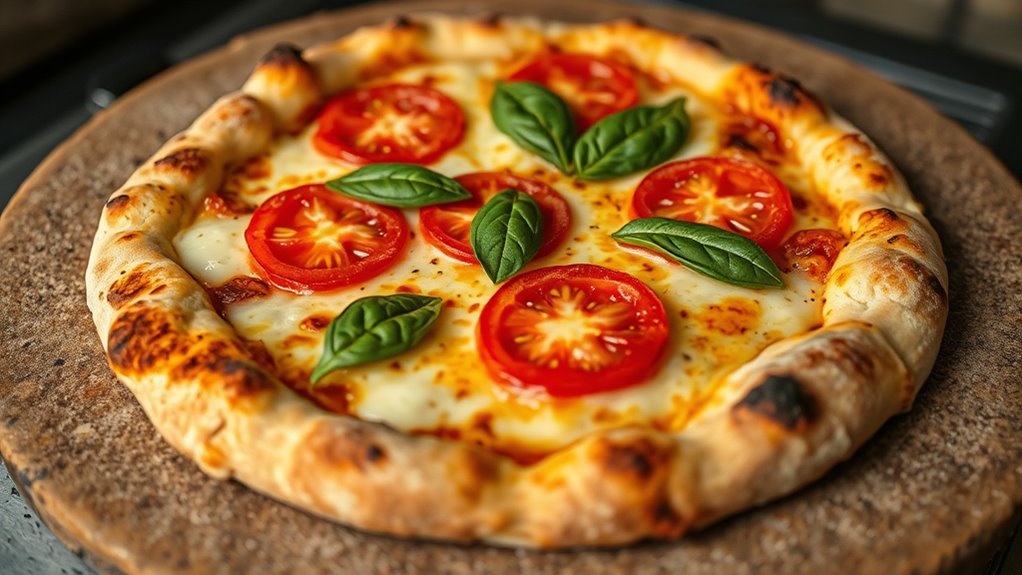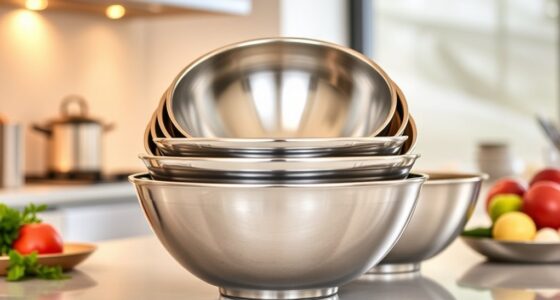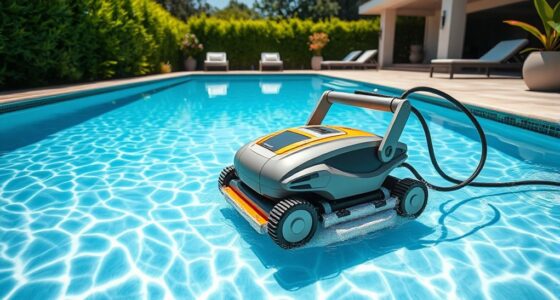Preheating your pizza stone thoroughly, ideally for at least 45 minutes to an hour at 500°F, makes a real difference in achieving a crispy crust at home. Proper handling, including gradual cooling and avoiding rapid temperature changes, prevents damage and helps maintain performance. Using a high-quality, porous ceramic or steel surface combined with high oven temperatures and the right dough can produce restaurant-quality results. Curious about how to maximize your pizza’s crust with these techniques? Keep exploring to find out more.
Key Takeaways
- Proper preheating (45-60 minutes at 500°F) ensures effective heat transfer, crucial for achieving a crispy crust with a pizza stone.
- Ceramic stones promote crispiness through moisture absorption and even heat distribution; material choice impacts crust texture.
- Using a preheated baking surface like steel or ceramic, combined with high oven temperatures, enhances crust crispiness at home.
- Adequate dough hydration and thin shaping work synergistically with a hot stone to produce professional-quality, crispy pizza.
- Proper handling, cooling, and maintenance of the stone extend its lifespan and sustain optimal performance for crispy crusts.
Does Preheating the Pizza Stone Really Make a Difference?
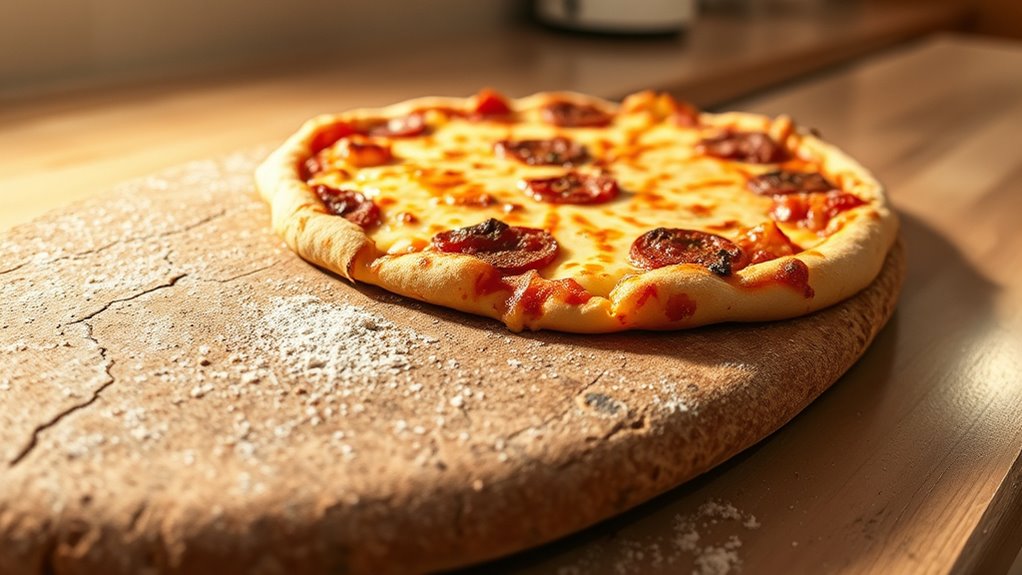
Preheating your pizza stone is essential if you want a crispy, evenly baked crust. When you preheat the stone at 500°F for at least 45 minutes, it reaches a high temperature that promotes ideal heat transfer. A hot oven alone isn’t enough; the stone’s heat radiates directly into the dough, creating that perfect crisp crust. Without proper preheating, the heat transfer is uneven, leading to a soggy bottom and less browning. The initial burst of heat from a well-preheated stone helps the dough puff up, forming bubbles and a light texture. While you can still make pizza without preheating, doing so considerably improves crust quality. Preheating ensures your pizza bakes evenly, giving you that professional, restaurant-style finish you crave. Additionally, the stone’s heat retention properties help maintain consistent temperatures throughout the baking process, resulting in a superior crust. Proper preheating also helps activate the stone’s thermal mass, which further enhances heat distribution for an even bake. In fact, the natural materials used in pizza stones are designed to store and transfer heat efficiently, making preheating a crucial step. To maximize the benefits, it’s also important to use a baking surface that can withstand high temperatures and promote even heat distribution during baking.
How Long Should You Preheat Your Pizza Stone for Optimal Results?

To get the best crust, you should preheat your pizza stone for at least 45 minutes at 500°F or higher. This guarantees even heat distribution and prevents cracks caused by sudden temperature changes. Keeping an eye on your oven’s temperature helps you hit that perfect preheat time for bakery-quality results. Additionally, using a self-watering system can help maintain consistent moisture in your dough, leading to a better rise and crispier crust. Incorporating a pizza stone with proper preheating techniques can significantly enhance your baking outcomes and achieve that authentic pizzeria texture. Being aware of cybersecurity vulnerabilities during your baking setup can prevent disruptions if your smart oven or connected kitchen devices are affected. Moreover, understanding AI integration in smart appliances can help optimize your baking process through automation and precise temperature control.
Preheat Duration Needed
For the best results, you should preheat your pizza stone for at least 45 minutes to an hour at 500°F. This preheat time allows your hot pizza stone to reach the ideal temperature needed for a crisp crust. Most manufacturers recommend a full hour of preheating duration to guarantee the stone absorbs and evenly distributes heat. Shorter preheating times, like 20-30 minutes, often result in insufficient heat transfer, which can lead to a less crispy crust. To verify your oven temperature and guarantee the stone has heated properly, consider using an oven or infrared thermometer. Proper preheating duration is essential for preventing sticking and achieving the perfect puffing and browning of your pizza crust. Additionally, using data analytics can help monitor and optimize your oven’s temperature consistency for even better results, especially as oven technology advances. Maintaining consistent oven temperature is crucial for achieving reliably crispy crusts every time, and understanding how heat transfer works can further enhance your pizza baking techniques.
Achieving Even Heat
Ensuring even heat distribution across your pizza stone hinges on proper preheat time. You should preheat the stone in a cold oven for at least 45 minutes to an hour at 500°F or higher. This gradual process helps prevent thermal shock and guarantees the stone reaches the desired temperature uniformly. Use an oven thermometer to verify the actual oven temperature, as many home ovens can be off, affecting preheat effectiveness. Avoid rushing the process with a quick preheat; less than 45 minutes can lead to uneven heat transfer, resulting in less crispy crusts. For best results, place the pizza stone on a cookie sheet or rack while preheating, allowing the heat to evenly penetrate the stone and promote ideal cooking conditions.
Preventing Cracks
Preheating your pizza stone for at least 45 minutes to an hour at 500°F or higher allows it to reach a uniform, high temperature, which is essential for preventing cracks. Sudden temperature changes can cause thermal shock, risking cracks or breakage. To avoid this, always preheat gradually along with your oven, ensuring even heating. After baking, let the stone cool completely inside the oven before removing or cleaning it—shocking it with cold water or ingredients can cause damage. Avoid placing cold dough directly on a hot stone, as this stress can also lead to cracking. Using a well-made, thick stone and following proper preheating and cooling procedures help maintain its integrity, extend its lifespan, and keep your pizza crispy without risking damage from thermal shock. Proper handling of the stone is crucial for safety and longevity, especially considering the thermal expansion properties of ceramic materials. Additionally, understanding material science principles can help prevent accidental damage and maintain optimal performance. Ensuring correct thermal shock resistance can further prolong the life of your pizza stone and ensure consistent results.
Can a Cold Pizza Stone Cause Cracking or Damage?

Can placing a cold pizza stone directly into a hot oven cause damage? Yes, it can. When you put a cold pizza stone into a hot oven, it undergoes thermal shock, which may lead to cracking or even damaging the stone. Most manufacturers suggest starting with a preheated pizza stone to prevent this, allowing gradual heating. Sudden temperature changes are risky, whether heating or cooling. Here’s a quick comparison:
| Aspect | Impact |
|---|---|
| Cold pizza stone | Risks thermal shock if placed in hot oven |
| Preheated pizza stone | Reduces cracking risk |
| Rapid cooling (water, air) | Can cause cracks if hot stone cools quickly |
| Gradual heating | Best practice for longevity |
| Material resistance | Some stones withstand thermal stress better |
Always handle your stone with care, heating and cooling gradually to avoid damage. Proper thermal expansion properties are essential for the longevity of your pizza stone, especially considering material properties that influence how well it tolerates thermal stress.
Is It Necessary to Let the Stone Cool Before Cleaning?

You should always let your pizza stone cool completely before cleaning to make sure it remains undamaged. Cleaning a hot or warm stone with water can cause sudden temperature changes that may crack or warp the material. Waiting ensures the stone stays intact and lasts longer.
Prevents Thermal Shock
To prevent thermal shock and protect your pizza stone from cracking, it’s essential to let it cool completely inside the oven before cleaning. Rapid cooling, such as rinsing with water while hot, causes sudden temperature changes that can lead to cracks. Allowing the stone to cool gradually inside the oven helps maintain its structural integrity and prevents thermal shock. Never expose a hot, seasoned, or uncooled stone directly to cold water or water spray, as this increases the risk of damage. Preheating the oven with the stone inside ensures even heating, reducing the chance of stress fractures. By giving your pizza stone ample cooling time, you preserve its durability, ensuring consistent baking performance and a longer lifespan.
Maintains Stone Integrity
Allowing your pizza stone to cool completely before cleaning is essential for maintaining its structural integrity. When you let it cool completely inside the oven, you prevent cracking caused by thermal shock. Heating or cleaning the stone while it’s still hot can cause rapid temperature changes that damage its porous ceramic and porous structure. Always wait until the stone has cooled to room temperature before removing it and cleaning with a brush or damp cloth. Cooling the stone gradually helps preserve its porous material, ensuring it remains durable and effective over time. Never expose a hot pizza stone to water or cleaning agents, as sudden cooling can cause it to crack or break. Proper cooling safeguards the stone’s integrity, extending its lifespan for repeated use.
Does Cooking at a Higher Temperature Always Ensure a Crispy Crust?
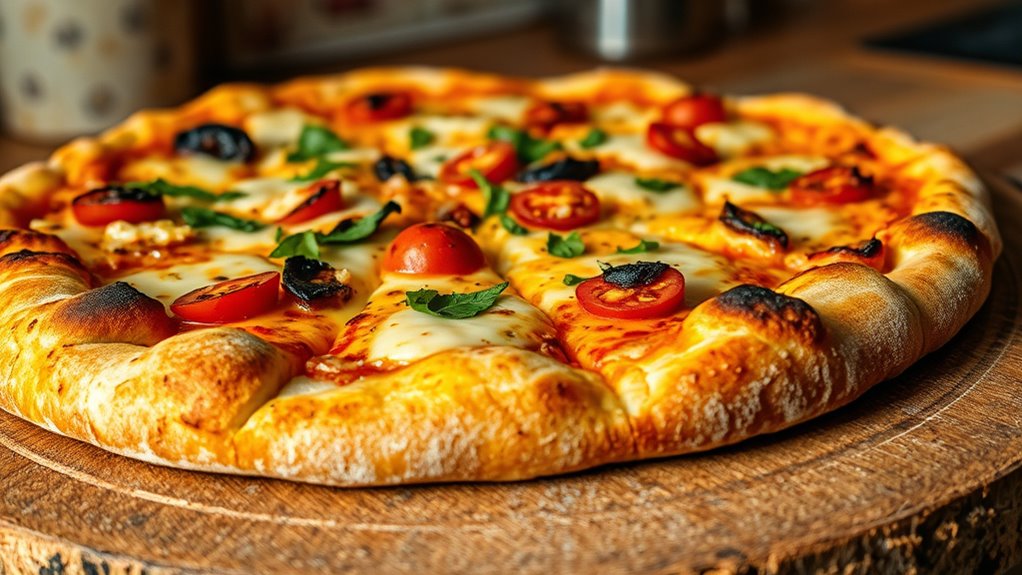
Does simply increasing the oven temperature guarantee a crispy pizza crust? Not necessarily. While high heat—above 500°F—can help, it’s not enough on its own. Using a pizza stone is essential because it promotes better heat transfer, drawing water out of the dough and helping you achieve that desirable crisp crust. Proper preheating is also vital; if your stone isn’t fully heated, the crust might remain soggy despite the high temperature. Keep in mind that other factors matter too, like dough hydration, toppings moisture, and baking time. So, turning up the oven isn’t a magic fix. To get a truly crispy crust, you need a combination of high heat, effective heat transfer from a preheated pizza stone, and mindful baking practices.
Can You Achieve Restaurant-Quality Pizza Without a Stone?

Achieving restaurant-quality pizza at home without a traditional pizza stone is entirely possible by focusing on oven temperature and baking surface. Start with high heat—preheat your oven to 500°F or higher—and guarantee your baking surface, like a steel or metal sheet, is thoroughly preheated. A hot oven and baking surface transfer heat efficiently, helping your pizza dough develop a crisp crust similar to that achieved with a stone. Using a steel baking surface conducts heat better than ceramic, often delivering superior results. Proper dough hydration and thin shaping also play vital roles in achieving a professional look and texture. By combining these techniques, you can produce a delicious, crispy-crust pizza without relying on a pizza stone.
How Does the Material of Your Baking Surface Impact Crust Crispiness?
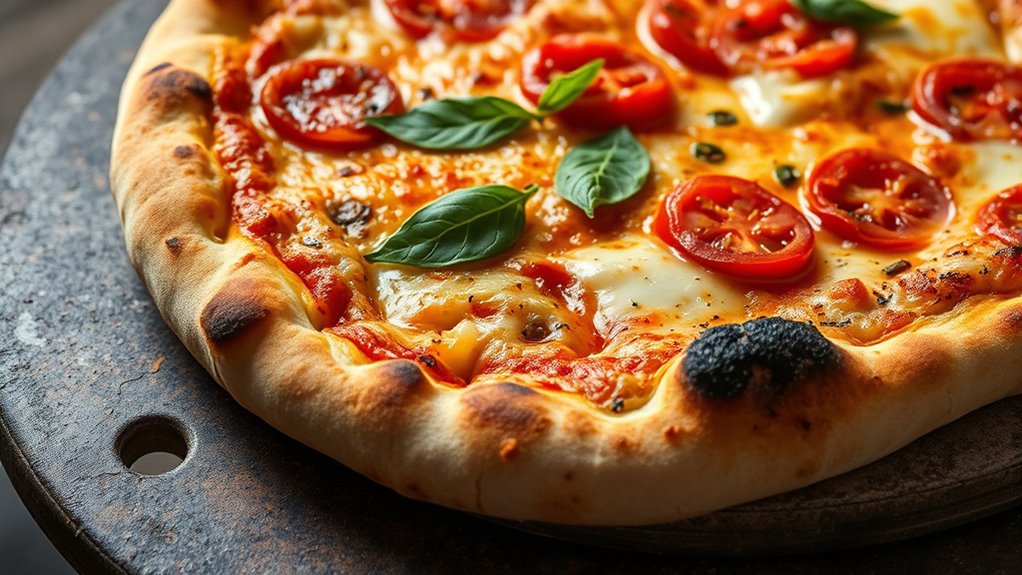
The material of your baking surface plays a significant role in how crispy your pizza crust turns out. Ceramic pizza stones are porous, allowing moisture to escape and helping create a crispier crust compared to non-porous metal baking surfaces. Their higher thermal conductivity means heat transfers faster and more evenly to your dough’s bottom, promoting perfect crispiness. In contrast, metal baking sheets heat up quickly but conduct heat less efficiently, often resulting in a softer crust. The porous nature of ceramic stones draws moisture from the dough during baking, which is vital for achieving a golden, crispy crust.
Ceramic stones promote moisture escape and even heat transfer for a crispier, golden crust.
Key points:
- Porous ceramic promotes moisture escape
- Higher thermal conductivity ensures even heat transfer
- Metal heats quickly but less efficiently
Are There Specific Toppings or Dough Types That Benefit More From a Stone?
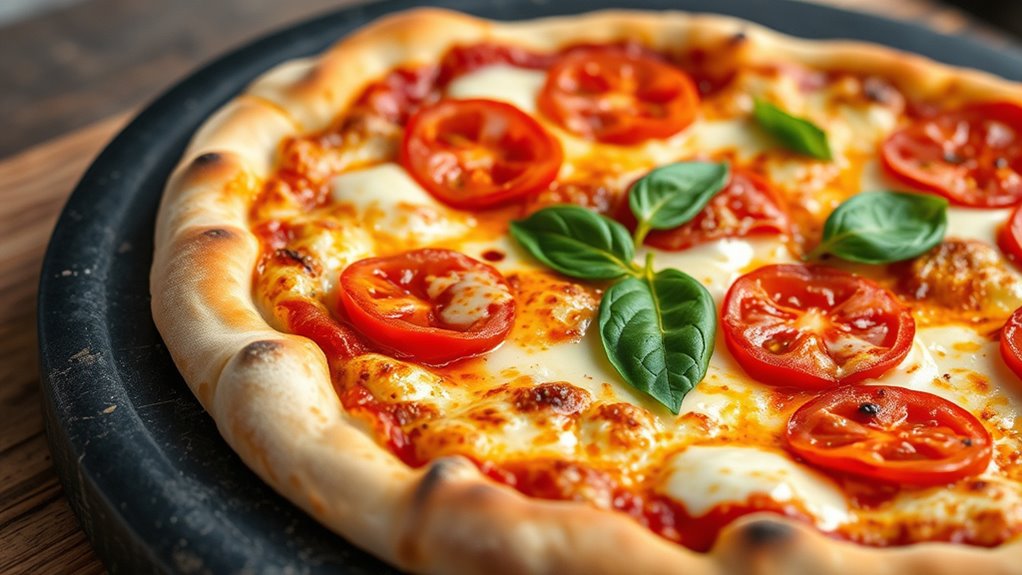
Certain dough types and toppings benefit more noticeably from a pizza stone’s properties. Neapolitan-style dough with high hydration and a thin crust responds well, achieving puffiness and a crisp crust. Thicker or lower hydration doughs show less improvement. Toppings that release moisture, like fresh tomatoes or watery vegetables, benefit from the stone’s porous surface, helping prevent sogginess. Ingredients like olive oil or sugar in dough promote even browning, enhancing flavor and appearance. Delicate toppings, such as fresh herbs or light cheeses, gain less from the stone but still benefit from its even heat distribution.
| Dough Type | Topping Type | Benefit from Stone |
|---|---|---|
| Neapolitan | Moisture-releasing | Prevents sogginess |
| Thick crusts | Light cheeses | Even browning |
| Low hydration | Fresh herbs | Consistent heat distribution |
What Are Common Mistakes That Diminish the Effectiveness of a Pizza Stone?
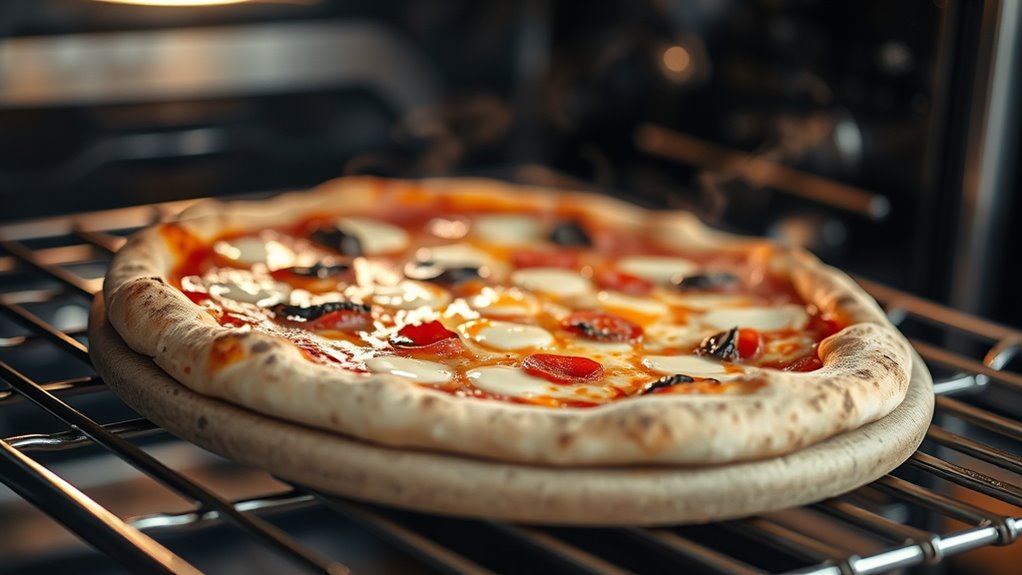
One common mistake that reduces a pizza stone’s effectiveness is failing to preheat it long enough. You should preheat the stone for at least 45 minutes to an hour to guarantee ideal heat transfer, resulting in a crispy crust. Rushing the cooling process can cause thermal shock, cracking the stone and impairing its heat retention. Additionally, placing cold dough or a frozen pizza on a hot stone hampers heat transfer, leading to soggy crusts. To maximize performance, avoid these pitfalls:
Preheat your pizza stone for at least 45 minutes to ensure crispy, evenly cooked crusts.
- Not preheating long enough
- Cooling or removing the stone too quickly
- Using soap or improper cleaning methods that clog pores
Proper cleaning and avoiding rapid temperature changes help maintain the stone’s porosity and heat transfer properties, ensuring consistent, crispy results.
Frequently Asked Questions
Does a Pizza Stone Make the Crust Crispier?
Yes, a pizza stone can make your crust crispier. When you preheat the stone properly, it transfers heat efficiently to the dough, helping it cook evenly and develop a crunchy bottom. The porous surface also draws moisture away, enhancing crispness. Just remember, factors like dough hydration and oven temperature matter too. With the right prep and patience, you’ll get a noticeably crispier crust at home.
Why Is My Pizza Crust Soggy on a Pizza Stone?
Your pizza crust gets soggy because the pizza stone isn’t hot enough or you add too much moisture. To fix this, preheat the stone thoroughly before baking, and use a little cornmeal or parchment paper to prevent sticking. Avoid overloading with watery toppings and let your pizza rest a minute after baking. These simple steps guarantee a crispy crust, making your homemade pizza just as good as pizzeria quality.
Does a Pizza Stone Really Make a Difference?
You might wonder if a pizza stone really makes a difference. The answer is yes—when you preheat it for at least 45 minutes, it absorbs and distributes heat evenly, helping you get a crispier, more evenly cooked crust. The porous surface draws moisture away from the dough, enhancing browning. Many home bakers notice a clear improvement in crust quality, making your pizza taste more like it’s from a pizzeria.
How to Get Crispier Pizza Crust?
To get a crispier pizza crust, you need to focus on a few key steps. Preheat your oven and pizza stone thoroughly, use a thin layer of cornmeal to prevent sticking, and bake directly on the hot stone for maximum heat transfer. Avoid overcrowding toppings to prevent sogginess, and crank up the oven to its highest temperature. These steps combine to deliver that perfect, crispy crust everyone loves.
Conclusion
Ultimately, mastering pizza stone power is like tending a delicate garden—you need patience, the right environment, and attention to detail. Preheat thoroughly, choose quality materials, and don’t rush the process. While a stone can be your secret weapon for that perfect crunch, remember that even the best tools require care. With practice, you’ll cultivate crispy, restaurant-style crusts right in your own kitchen, turning each pizza into a masterpiece blooming from your culinary garden.
